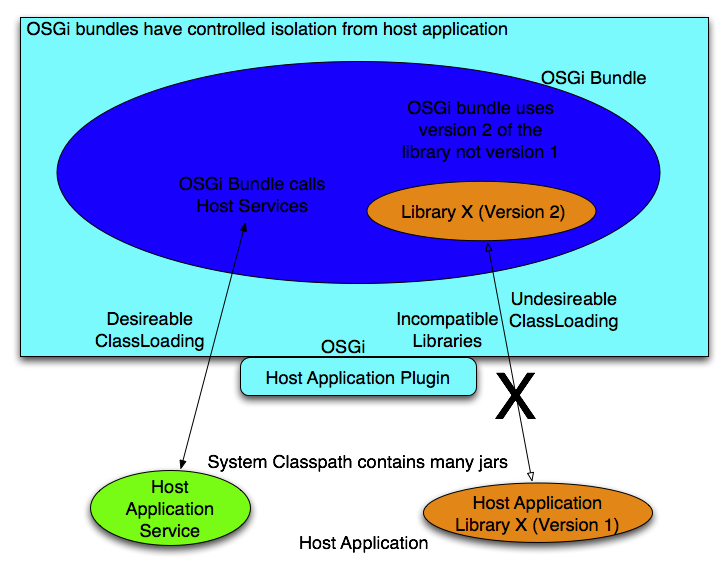Difference between revisions of "Embedding OSGi"
(→Embedding OSGi inside a host application: (checkpoint save)) |
((checkpoint save)) |
||
| Line 12: | Line 12: | ||
PluginImpl class. The PluginImpl class then immediately starts up OSGi and the work of the plugin is then done in the OSGi environment. | PluginImpl class. The PluginImpl class then immediately starts up OSGi and the work of the plugin is then done in the OSGi environment. | ||
| − | There are two | + | [[File:EmbeddedOSGiArch.png]] |
| + | |||
| + | |||
| + | There are two main points that this example is intended to demonstrate. First, the OSGi application is able to call host services. To do this, when the plugin is initialized | ||
My example included a class loader conflict. There is a library (conflict.jar) used by the host application. The plugin for the hsot application needs to use the same routines from the library but needs to use a different version of the library (conflict-v2.jar). | My example included a class loader conflict. There is a library (conflict.jar) used by the host application. The plugin for the hsot application needs to use the same routines from the library but needs to use a different version of the library (conflict-v2.jar). | ||
Revision as of 12:22, August 7, 2009
Embedding OSGi inside a host application
There are many reasons to embed OSGi inside a host application:
- the host application may have an extension mechanism that offers plugins no classloader protection from other extensions. This means that version problems can crop up between different extensions.
- you have an existing OSGi implementation (e.g. Protege 4) which you want to run in a non-OSGi application setting.
There are several examples of OSGi showing up on the web. In particular, the Apache and Equinox groups have teamed up to devise a scheme that works with tomcat. Inside the OSGi environment, bundles see the standard OSGi servlet services which are transparently mapped to the underlying tomcat implementation. In response to a potential Protege developer who was having serious classloader problems I implemented the following demonstration of how a plugin for a host application can be implemented inside a embedded OSGi environment. The demonstration can be checked out and run by executing ant run.
In the HostApplication project, I simulated the host application (Host.java). This application finds and initializes a plugin (PluginImpl.java). I did not simulate the plugin mechanism inside the host application; the call to initialize the plugin is a simple call to a member of the PluginImpl class. The PluginImpl class then immediately starts up OSGi and the work of the plugin is then done in the OSGi environment.
There are two main points that this example is intended to demonstrate. First, the OSGi application is able to call host services. To do this, when the plugin is initialized
My example included a class loader conflict. There is a library (conflict.jar) used by the host application. The plugin for the hsot application needs to use the same routines from the library but needs to use a different version of the library (conflict-v2.jar).
